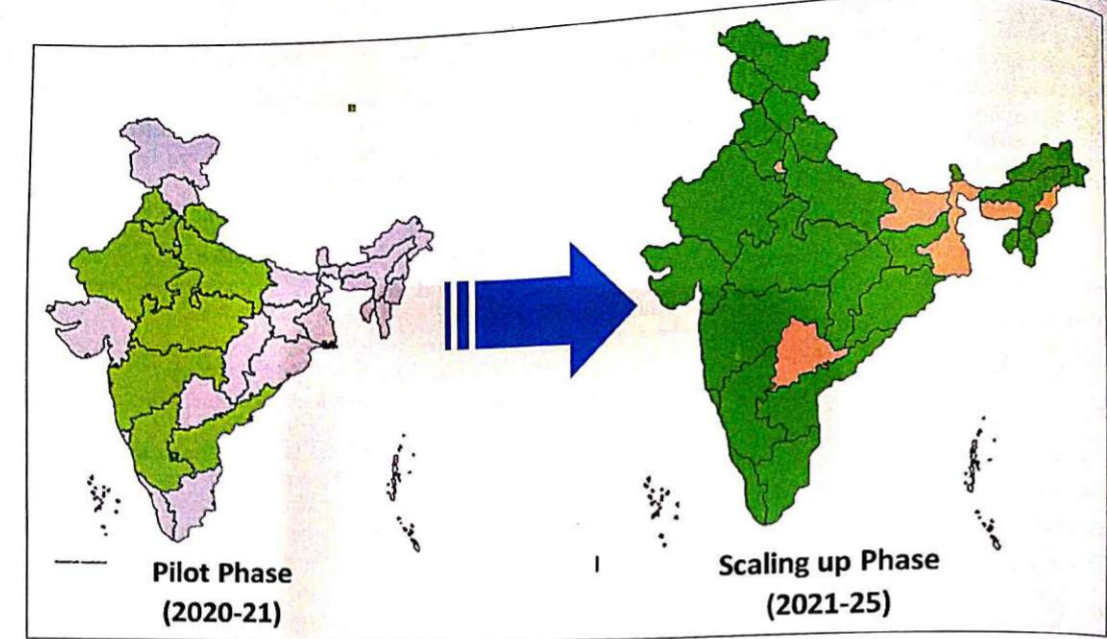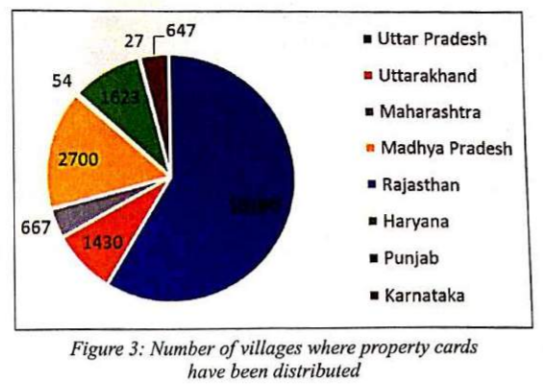ForumIAS announcing GS Foundation Program for UPSC CSE 2025-26 from 19 April. Click Here for more information.
Contents
- 1 Introduction
- 2 About the objectives of the PM SVAMITVA Scheme
- 3 Coverage of the PM SVAMITVA Scheme
- 4 What are the achievements of the PM SVAMITVA Scheme so far?
- 5 Why the PM SVAMITVA Scheme is needed?
- 6 What are the challenges in the traditional land survey method?
- 7 What are the major advantages of the PM SVAMITVA Scheme?
- 8 What are the other benefits provided by PM SVAMITVA Scheme?
| For 7PM Editorial Archives click HERE → |
Introduction
The PM SVAMITVA Scheme (Survey of Villages Abadi and Mapping with Improvised Technology in Village Areas) aims to provide the ‘record of rights’ to village household owners possessing houses in inhabited rural areas and issuance of property cards to the property owners.
Property owners in rural inhabited areas can download the Aadhaar authenticated property card on their mobile phones through the DigiLocker application.
Based on the Socio-Economic and Caste Census-2011 (SECC-2011) estimates of rural areas in India, the number of households expected to be benefitted from the Scheme is approx. 13.13 crores.
About the objectives of the PM SVAMITVA Scheme
1. Leveraging property as a financial asset by the citizens of rural India, 2. Creation of accurate land records for rural planning, 3. Provide an integrated property validation solution for rural India, 4. Serve as a means of reduction in property-related disputes, 5. Facilitate the determination of property tax, 6. Creation of survey infrastructure and GIS (Geographic Information System) maps that can be used by any department or agency.
Coverage of the PM SVAMITVA Scheme

The pilot phase of the Scheme was rolled out in April 2020 in six States. Namely, Haryana, Karnataka, Madhya Pradesh, Maharashtra, Uttar Pradesh, and Uttarakhand.
Based on the successful implementation and outcome of the pilot phase, the Scheme was rolled out for implementation across all States/UTs on 24 April 2021.
So far, 28 States and UTs have signed MoU with Survey of India for implementation of SVAMITVA Scheme in their States/UTs. The State of Tamil Nadu is in the final stages of signing MoU for pilot villages.
What are the achievements of the PM SVAMITVA Scheme so far?
As of September 2021, drone flying has been completed in 59,145 villages across nine States. Property cards have been distributed in approx 17,000 villages, which comprise nearly 17 lakh property owners.
Many property owners have also started availing of loans through property cards for constructing houses or setting up small businesses.
There have also been instances of settlement of long pending property disputes among residents of villages during the implementation of the Scheme.
Why the PM SVAMITVA Scheme is needed?
No proper record available for household owners: As far as non-agricultural property rights in rural India are concerned, very few studies exist that provide statistical estimates of the record of rights for residential land in rural India. The surveys like the National Family Health Survey (NFHS) or India Human Development Survey (IHDS) take into account either the agricultural land or all land without segregating the inhabited (abadi) land.
High rural indebtedness for rural household assets: When it comes to access to institutional credit, as per the Household Assets and Indebtedness Survey 2013 conducted by the Ministry of Statistics and Programme Implementation (MoSPI), about 20% of households have reported outstanding credit with non-institutional lenders, while the same number is at 10% for urban India.
The land retains a high share of total assets in India: In India, an average household has 77% of its total assets in real estate (residential buildings, buildings used for farms and non-farm activities, constructions such as recreational facilities, and rural and urban land). This is high when compared to the USA (40%), China(60%), Thailand(50%) and the UK(35%).
What are the challenges in the traditional land survey method?
Multiple issues: Traditional surveying techniques generally require line-of-sight and a clear vision of the whole area to be surveyed. Further, the surveyor has to move with measuring instruments from one place to another for demarcating property parcels. This methodology of land survey is laborious, time-consuming, expensive, and prone to human as well as instrumental errors.
Lack of Record of Rights (RoR) in the rural inhabited areas in India results in a low level of land governance, presumptive ownership of properties, long pending property-related disputes and illiquid land market in rural areas.
What are the major advantages of the PM SVAMITVA Scheme?
Use digital technologies: SVAMITVA Scheme uses the combination of Survey Grade Drones and CORS network (Continuously Operated Reference Stations) to accurately survey large areas in a very short span of time. This has the following advantages, 1. Provide very high accuracy and high-resolution maps, 2. Provide editable and Geo-tagged Maps, 3. Creation of the most durable record of property holdings in areas with no legacy revenue records, 4. Provide a clear demarcation of land holdings in a very short time, 5. Free from measurement errors to a large extent.
What are the other benefits provided by PM SVAMITVA Scheme?
Provide access to institutional credit: In the absence of a legal document, the owner of the property in the rural areas is not able to leverage it as a financial asset acceptable by the banks to provide loans and other financial assistance. With the PM SVAMITVA Scheme, rural areas can get easy access to formal credit.
Benefits to Gram Panchayats: The creation of accurate land records and GIS maps will support Panchayats in the preparation of a better-quality Gram Panchayat Development Plan (GPDP).
Through the accurate determination of properties and transparent land titles, Gram Panchayats will be able to streamline their property tax determination and collections in the States in which they are devolved to them.
Trickle-down benefits of CORS: 567 CORS network will be established as a public infrastructure over the course of the Scheme. This will facilitate geo-positioning services and other developmental activities by any department or agency.
Will provide impetus to the drone ecosystem: Currently, there are nearly 119 drones deployed in various States for conducting drone surveys and the number will soon increase to 300. The Production-Linked Incentive (PLI) Scheme of the Ministry of Civil Aviation will provide opportunities for Startups and MSMEs.
Thus, SVAMITVA Scheme aims for the holistic development of Gram Panchayat through the empowerment of villages and their residents, which will eventually make rural India Atmanirbhar.





